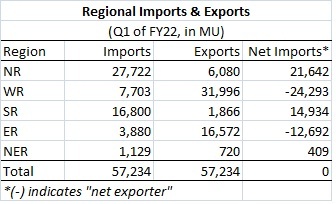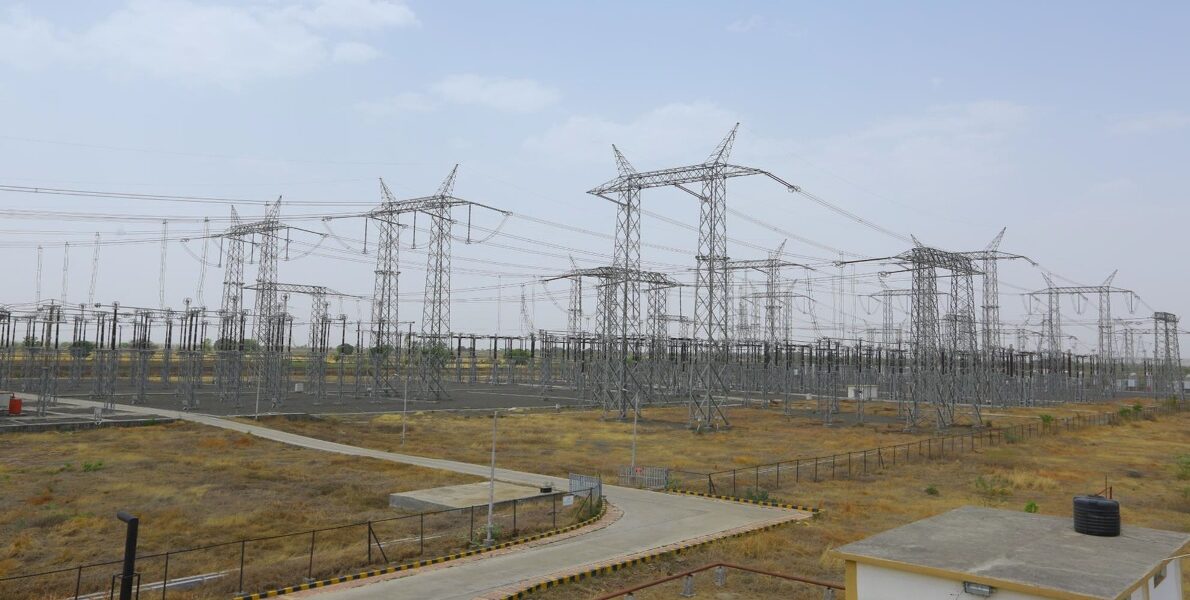The volume of interregional power transfer was up nearly 18 per cent year-on-year during the quarter ending June 30, 2021, according to statistics recently released by National Load Despatch Centre (NLDC).
Statistics indicate that the total interregional electricity transfer during the first quarter (Q1, April to June) of FY22 was 57,234 MU (million units or million kwh or Gwh). This was 17.6 per cent higher than the comparable 48,679 MU in Q1 of FY21.
Bulk of the total transfer during Q1 of FY22 was from the Western Region Grid (WR) to the Northern Region Grid (NR). This transfer amounted to 20,856 MU, accounting for 36 per cent of the total interregional transfer in the first quarter of FY22. It is also worth observing that this WR-NR transfer was 31 per cent higher than its level in Q1 of FY22.
Transfer from the Eastern Region (ER) to the Southern Region (SR) was the next biggest chunk, at 9,161 MU, representing a share of 16 per cent. Other significant transfers included WR-SR (at 7,639 MU), ER-NR (6,428 MU) and NR-WR (5,387 MU).
What is noteworthy is the significant growth in transfer from NR to WR. The Northern Region is a consumption centre and usually imports electricity from other generation centres, mainly WR and ER. Depending on the situation, there could also be transfers FROM the Northern Region. However, such transfers are few, in normal circumstances. It is therefore interesting to note that during Q1 of FY22, the volume of NR-WR transfer (from NR to WR) was nearly 40 per cent higher than in the same quarter of FY21.
The Western Region also imported a significant volume of electricity from the Southern Region. (This by itself is unusual as it is the Southern Region that is a net importer, as seen in the latter part of this story.) This SR-WR transfer stood at a significant 1,846 MU in Q1 of FY22, as against just 436 MU in Q1 of FY21. It may be mentioned that the newly-commissioned Raigarh-Pugalur HVDC link will form an important agent for bilateral transfer between WR and SR.
Also read : Interregional Power Transfer Up 23 Per Cent In First Two Months Of FY22
Net importers and exporters
 A study by T&D India, based on NLDC statistics, suggests that the Northern, Southern and Northeastern Regions (NR, SR and NER, respectively) were net importers of electricity, while the other two regions (WR and ER) were net exporters. In a general sense, WR, ER and NER are considered as power generation centres and are usually net exporters of electricity. In the case of NER, which is dominated by hydropower, export of electricity is highest during the monsoons. This falls during the second and third quarter of the standard financial year, ending March 31. For the remaining part of the year, NER is usually a net importer, as reflected in the statistics of Q1 of FY22.
A study by T&D India, based on NLDC statistics, suggests that the Northern, Southern and Northeastern Regions (NR, SR and NER, respectively) were net importers of electricity, while the other two regions (WR and ER) were net exporters. In a general sense, WR, ER and NER are considered as power generation centres and are usually net exporters of electricity. In the case of NER, which is dominated by hydropower, export of electricity is highest during the monsoons. This falls during the second and third quarter of the standard financial year, ending March 31. For the remaining part of the year, NER is usually a net importer, as reflected in the statistics of Q1 of FY22.
In Q1 of FY22 (see table), NR was a net importer to the tune of 21,642 MU, followed by SR with 14,934 MU and NER with a nominal 409 MU. WR was a net exporter with a 24,293 MU with SR coming next n order with 12,692 MU.
India’s National Grid, with a capacity of over 103 GW, facilitates seamless transfer of electricity between the five regional grids—NR, WR, ER, SR and NER. Nearly 85 per cent of this interregional transfer capacity comes through transmission systems owned by Power Grid Corporation of India Ltd (PGCIL).
(Featured photograph is for illustration only)



